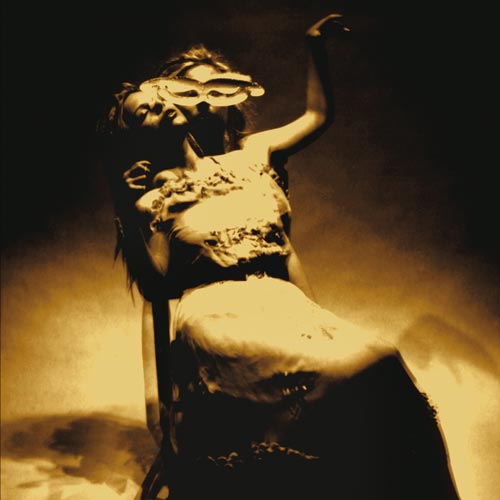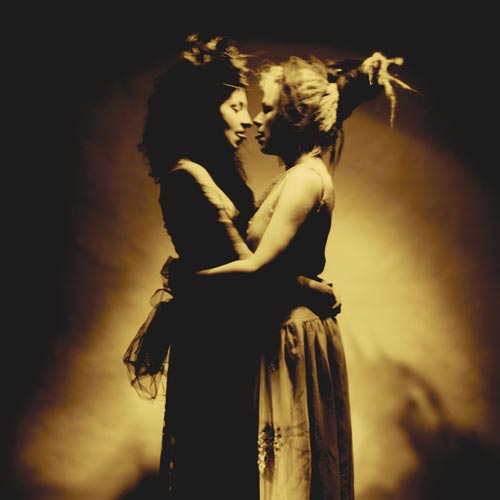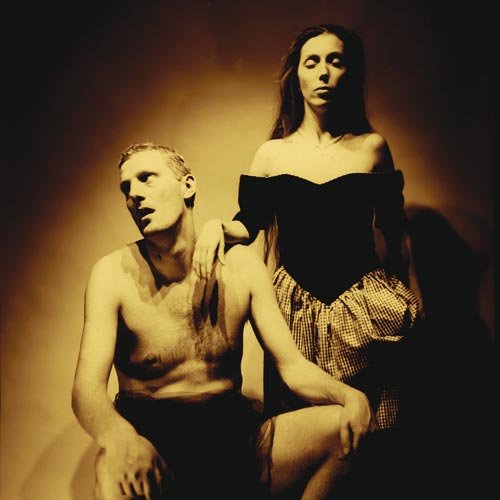

"Incarnations" - original size 50x70 cm

"Antigravitation" - original size 50x70 cm

"Antigravitation" - original size 50x70 cm
Forgotten Reality
The work of Piotr Komorowski may be clearly divided into two stages. The first is marked by his fascination with elementary photography, the second indicates a turn towards staged photography and a metaphor. Two series of photographs, presented at the current exhibition, called Incarnations and Antigravitation, seem similar in visual terms and at first glance appear to resemble staged portraits. The author himself has said that they present "a universal image of contemporary man". Komorowski in his Komentarz - analiza (do w³asnych dzia³ań w zakresie fotografii) [Commentary - Analysis (Towards My Own Photographic Workings)] points out that we are aware of the existence of "the back side, or better, the flip side of a photograph" which complements information about photographed objects that are viewed only on one side of the photograph. Thus photography seems to be something like an impulse which triggers the confrontation of reality with a mental image, but most of all initiates the vision of what does not and did not previously exist in reality or even in the photograph itself. I do not have in mind any kind of deformation of reality, achieved, for example, by means of staging or montage, but rather the saturation of an image with a multitude of meanings, symbols and hidden subtexts. Photography had been identified with a mirror earlier (John Szarkowski). In those days photography's "purity" and the so-called anti-decorativeness were its advantages in confrontation with the aestheticism of pictorialism in the young photography of the times. Nowadays calling photography a mirror in not in vogue any more. Perhaps because the consciousness of contemporary man does not allow us to see the authentic reality since the mental image of contemporary man has been formed mainly by mass media. This mental image has become the secondary image (a copy) of visual stereotypes watched every day, far flung or differing from true reality. That is why photography as a branch of contemporary art rarely tries to be a mirror. Acting like a filter, contemporary art of photography eliminates trivial and schematic visions of reality, as well as the deformed mask of reality, put on by mass media. However, thanks to photography the viewer may return to the archetype of the mental image. Photography performs the function of a forgotten diary of authentic reality. In this context we might agree with Piotr Komorowski who said that "today photography is the original, while reality is its copy".
In the Incarnation series Komorowski abandons the attributes of a classic portrait, like the identity and individualism of the people in the photograph, in favour of a certain uniform quality which can be observed in the frame and the lighting. Unification allows Komorowski to concentrate on what is common, universal and repetitive. He captures what is ascribed to us all - existence along with its burdensome and tragic manifestations. It is difficult to accept this narrative interpretation in a portrait because we are rather used to the idealization and glorification of the models portraited. This method of photographying people is certainly hard to acknowledge at first, but it provokes us all to ask a few fundamental questions about the human condition. Coming back once again to the comparison of photography to a filter we might say that the photographs from the Incarnation series have rejected everything that is connected with a classic portrait - likeness and appearance. The figures from those photographs almost always remind us of someone we know very well although we cannot remember who this person is. Incarnation portraits cause anxiety or longing after something or someone long forgotten. If we believe in reincarnation the people from Incarnations are our mythical embodiments. Looking at Piotr Komorowski's portraits we are trying to get through to the roots of reality.
In the Antigravitation series Komorowski employs a more elaborate kind of staging. At first glance those photos make us think of the theatre or 19 th century fashion photography. Perhaps this change of costume was supposed to demonstrate transformation and metamorphosis that leads into the world of false impressions and illusions. Komorowski's photographs from this series bring to mind strange apparitions from a short-lived moment between sleep and waking. Sharp, yellow light obliterates reality. On the other hand, the title of the series, Antigravitation, is rather difficult to interpret in unambiguous terms. The state of antigravity cannot be attained as it is against the law of physics. It can be attained only in one's sleep although in this case it resembles death - Hypnos was the brother of Thanatos. The characters in Komorowski's photographs are the embodiments of an ancient myth, told in the theatre which is rooted in ancient forms of religion. Those characters are fleeting and transitory in our memory but fixed in time thanks to photography, for ever. They are secure and will not fall into the nothingness of forgetfulness just like the characters from Max Ernst's sculpture Capricorn.
The latest photographs by Piotr Komorowski from the series called Self-liberation show the author himself, and as Komorowski says, "are the story of <tracking one's own carnality> (.) which became important to me after I had almost <given up the ghost>". The difference between those and previous photographs is illusive and it springs mainly from the external photographic form. The author in the photographs is an actor and the protagonist of the story which is concrete and has to do with himself, his body and his experience, literally speaking. The theatre became actuality and the myth that was told - reality. Those photographs are clearer, they do not contain as many symbolic references and as much mystery as before. Perhaps because the reality photographed was in this case more concrete and it did not demand additional manipulations and filtering, since it was authentic. I can see some similarity between the character of the author in the photographs - bound in a corset - and Max Ernst's chess figures - all the more so because the "character" of Komorowski in some of the photographs is moving on the floor of a washroom which looks like a chess-board. One feels anxiety and helplessness in those photographs as we do not have any control over the player who plays with our life and fate. That is when we feel that we resemble a helpless little creature, struggling frantically. Piotr Komorowski's photographs do not attempt to change the world or to comment upon it critically, but they change us because they enrich our imagination.
£ód¼, October 31st, 2006 Grzegorz Przyborek

"Antigravitation" - original size 50x70 cm

"Antigravitation" - original size 50x70 cm

"Incarnations" - original size 50x70 cm

Exhibition organized as part of an
OPERATIONAL PROGRAMME
"Art Promotion"
Copyright ©2006 Galeria FF £DK, Piotr Komorowski, Grzegorz Przyborek.